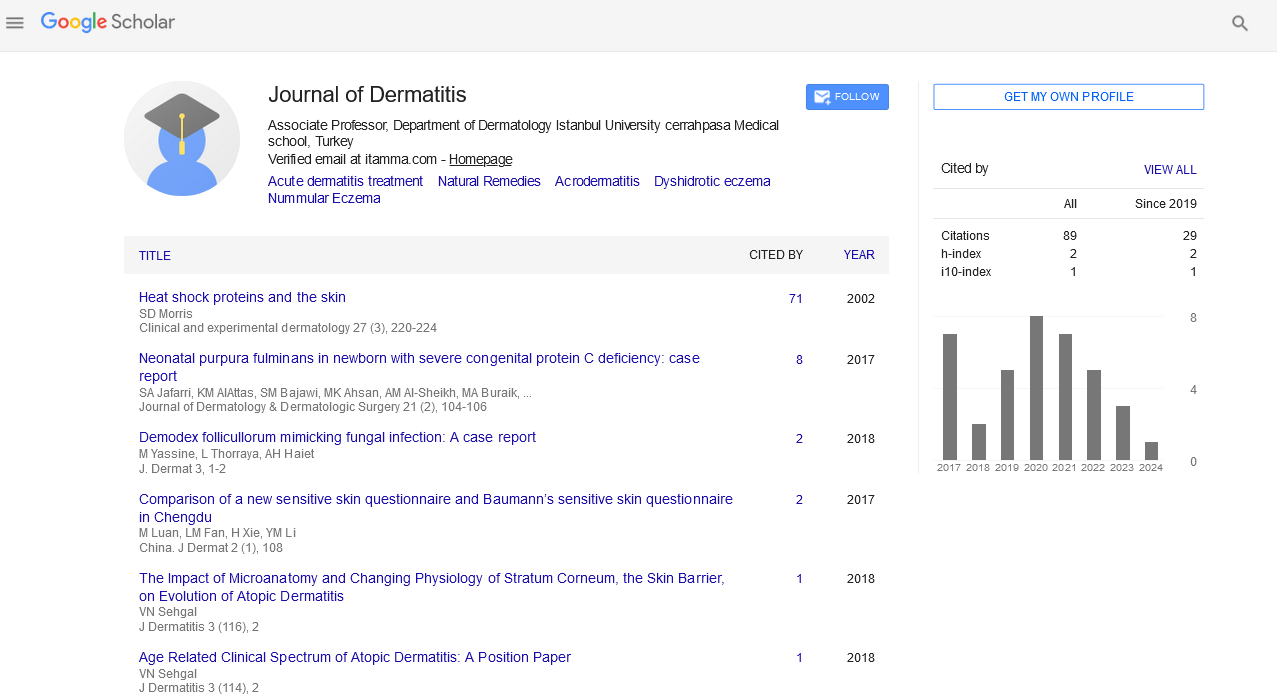Indexed In
- RefSeek
- Hamdard University
- EBSCO A-Z
- Euro Pub
- Google Scholar
Useful Links
Share This Page
Journal Flyer

Open Access Journals
- Agri and Aquaculture
- Biochemistry
- Bioinformatics & Systems Biology
- Business & Management
- Chemistry
- Clinical Sciences
- Engineering
- Food & Nutrition
- General Science
- Genetics & Molecular Biology
- Immunology & Microbiology
- Medical Sciences
- Neuroscience & Psychology
- Nursing & Health Care
- Pharmaceutical Sciences
Commentary - (2025) Volume 10, Issue 2
Dermatitis in Pediatric Populations: Epidemiology and Management
Michael Lee*Received: 19-Jan-2024, Manuscript No. JOD-24-24658; Editor assigned: 23-Jan-2024, Pre QC No. JOD-24-24658 (PQ); Reviewed: 06-Feb-2024, QC No. JOD-24-24658; Revised: 06-Jan-2025, Manuscript No. JOD-24-24658 (R); Published: 13-Jan-2025, DOI: 10.35248/2684-1436.25.10.277
Description
Dermatitis, characterized by inflammation of the skin, is a common dermatologic condition that can affect individuals of all ages, including pediatric populations. Pediatric dermatitis encompasses a spectrum of inflammatory skin disorders, each with its unique features and challenges. Understanding the epidemiology and implementing effective management strategies are important for addressing the specific needs of children with dermatitis, ensuring optimal care, and promoting their overall well-being.
Epidemiology of pediatric dermatitis
Dermatitis is a multifactorial condition influenced by genetic, environmental, and immunological factors. In pediatric populations, it ranks among the most common skin disorders, affecting approximately 10%-20% of children worldwide. The incidence of dermatitis has been steadily increasing over the past few decades, presenting a significant public health concern.
Various factors contribute to the development of dermatitis in children. Genetic predisposition plays a pivotal role, with a family history of atopic dermatitis increasing the likelihood of a child developing the condition. Environmental factors, such as exposure to allergens, pollutants, and climatic conditions, further contribute to the complex etiology of pediatric dermatitis.
The early onset of dermatitis is a common occurrence, with symptoms manifesting in infancy or early childhood. The prevalence tends to decrease with age, but some individuals may continue to experience symptoms into adolescence and adulthood. Girls are often more affected than boys during early childhood, but the gender difference diminishes with age.
Clinical presentation and impact on quality of life
Pediatric dermatitis typically presents with dry, itchy skin and red, inflamed patches. The affected areas commonly include the face, neck, elbows, and knees. The incessant itching can lead to scratching, which may result in open sores and increased vulnerability to bacterial infections.
The impact of dermatitis on the quality of life for affected children and their families is substantial. Chronic itching and discomfort can lead to sleep disturbances, irritability, and impaired concentration, affecting academic performance. Social and emotional well-being may also be compromised, as children with visible skin conditions may experience stigmatization and reduced self-esteem.
Management strategies
Effectively managing pediatric dermatitis requires a comprehensive approach that addresses both acute symptoms and long-term prevention. Treatment strategies may vary based on symptom severity, and a personalized plan should be developed in consultation with healthcare providers. Here are key components of dermatitis management in pediatric populations:
In cases of mild to moderate dermatitis, topical corticosteroids are often effective in reducing inflammation and itching. However, their long-term use should be monitored to mitigate potential side effects.
Regular application of emollients and moisturizers is crucial to maintain skin hydration and prevent dryness. The use of nonfragrant, hypoallergenic products is recommended to minimize the risk of irritation.
Identifying and avoiding triggers that exacerbate dermatitis is essential. Common triggers include allergens, irritants, and certain foods. Allergy testing may be recommended in some cases to pinpoint specific triggers.
Oral antihistamines can offer relief from itching and improve sleep. Sedating antihistamines may be prescribed for nighttime use to minimize sleep disturbances.
Providing education about the nature of dermatitis, emphasizing the importance of consistent skincare, and offering strategies to manage flare-ups is important. Empowering patients and caregivers through education promotes better adherence to treatment plans. In severe cases where conventional treatments prove ineffective, biologic therapies may be considered. These targeted medications modulate the immune response, effectively reducing inflammation.
Conclusion
Pediatric dermatitis poses a significant burden on affected children and their families, necessitating a comprehensive and individualized management approach. Understanding the epidemiology, clinical presentation, and management strategies is important for healthcare providers to deliver effective care. Ongoing research into the genetic and environmental factors influencing dermatitis development will further contribute to the refinement of treatment approaches, ultimately improving outcomes for pediatric patients with this challenging skin condition.Citation: Lee M (2025) Dermatitis in Pediatric Populations: Epidemiology and Management. J Dermatitis. 10:269.
Copyright: © 2025 Lee M. This is an open access article distributed under the terms of the Creative Commons Attribution License, which permits unrestricted use, distribution, and reproduction in any medium, provided the original author and source are credited.

